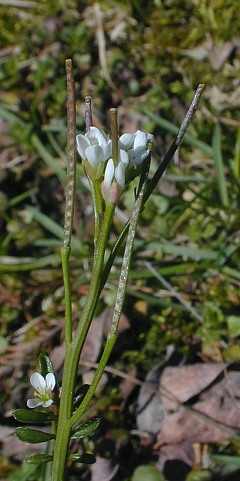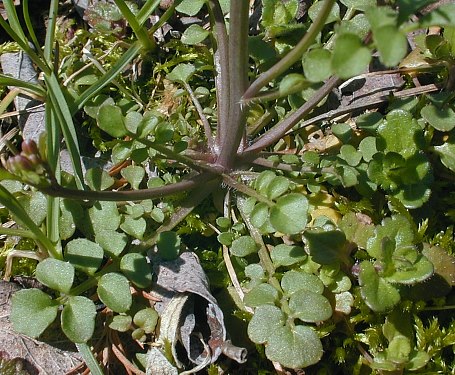Description:
This
plant is a winter annual or biennial. Initially, it forms a
low rosette of basal leaves spanning up to 8" across. Each basal leaf
is up to 4" long, ¾" across, and simple-pinnate, consisting of 5-9
leaflets and a long
petiole. The basal leaflets are orbicular to oval in shape and slightly
undulate along their margins; the outer leaflets are larger in size
than the inner leaflets. The basal petioles often have a few long hairs
along their margins and they are often dull purple. From the center of the rosette, there develops a flowering stalk up to 10" tall that is
unbranched or sparingly branched; this stalk is light green to dull
purple and hairless, except for a few long hairs toward its base. About
3-5 cauline leaves alternate along the stalk. The cauline leaves are
similar to the basal leaves, except they are shorter in length and
their leaflets are more narrow (linear-oblong to ovate-oblanceolate).
Sometimes long hairs are present along the margins of the cauline
leaflets and near the base of the cauline petioles. The central stalk
(and any secondary stalks) terminates in a raceme of flowers. The
flowers bloom near the apex of the inflorescence, while the seedpods
develop below. Each flower is less than ¼" across, consisting of 4
white petals, 4 sepals, 4 stamens, and a pistil with a single style.
The sepals are light green to dull purple, oblong in shape, and either
hairless or slightly hairy; they are shorter than the petals. The
blooming period occurs from early to mid-spring and lasts about a
month. Each flower is replaced by a narrowly cylindrical seedpod
(silique) up to 1" long. The seedpods are light green to dull purple,
hairless, and ascending; they have stout pedicels up to ½" long. Each
seedpod contains several small seeds that are ovoid, somewhat
flattened, and wingless along their margins. The root system is shallow
and fibrous. This plant spreads by reseeding itself.
the rosette, there develops a flowering stalk up to 10" tall that is
unbranched or sparingly branched; this stalk is light green to dull
purple and hairless, except for a few long hairs toward its base. About
3-5 cauline leaves alternate along the stalk. The cauline leaves are
similar to the basal leaves, except they are shorter in length and
their leaflets are more narrow (linear-oblong to ovate-oblanceolate).
Sometimes long hairs are present along the margins of the cauline
leaflets and near the base of the cauline petioles. The central stalk
(and any secondary stalks) terminates in a raceme of flowers. The
flowers bloom near the apex of the inflorescence, while the seedpods
develop below. Each flower is less than ¼" across, consisting of 4
white petals, 4 sepals, 4 stamens, and a pistil with a single style.
The sepals are light green to dull purple, oblong in shape, and either
hairless or slightly hairy; they are shorter than the petals. The
blooming period occurs from early to mid-spring and lasts about a
month. Each flower is replaced by a narrowly cylindrical seedpod
(silique) up to 1" long. The seedpods are light green to dull purple,
hairless, and ascending; they have stout pedicels up to ½" long. Each
seedpod contains several small seeds that are ovoid, somewhat
flattened, and wingless along their margins. The root system is shallow
and fibrous. This plant spreads by reseeding itself.
Cultivation:
Successful development is promoted by full to partial sunlight, moist
to mesic conditions, and a somewhat barren soil containing gravel or
clay. However, this weedy plant will adapt to fertile loam and sandy
soil as well. Most growth and development occurs during the early
spring when temperatures are cool and moisture is abundant.
Range & Habitat:
Hairy Bitter Cress is still rather uncommon in Illinois; it is more
likely to to be encountered in the NE and southern sections of the
state than elsewhere (see Distribution
Map). This weedy plant was introduced into North America from
Eurasia. Habitats
consist of cropland, old fields, margins of paths, roadsides, and waste
areas. Open habitats with a history of disturbance are preferred.
Faunal Associations:
The nectar and pollen of the flowers probably attract small bees and
flies. The caterpillars of the butterfly Anthocharis midea
(Falcate Orangetip) and the moth Evergestis pallidata
(Purple-Backed Cabbageworm) feed occasionally on Cardamine
spp.
Photographic
Location:
Along a gravelly path at Kickapoo State Park in Vermilion County,
Illinois.

Comments: Hairy Bitter Cress is one of several weedy plants in the Mustard family that is native to Eurasia. It closely resembles several other species in the Mustard family, including Sibara virginica (Virginia Rock Cress), Cardamine parviflora arenicola (Small-Flowered Bitter Cress), Cardamine pensylvanica (Pennsylvania Bitter Cress), and Cardamine flexuosa (Wavy Bitter Cress). Unlike Small-Flowered Bitter Cress and Pennsylvania Bitter Cress, Hairy Bitter Cress has hairy petioles (particularly the basal) and the base of its flowering stalk is often hairy. Unlike Virginia Rock Cress, it has basal leaflets that are about as long as across (orbicular, oval) and its seeds lack winged margins. Unlike Wavy Bitter Cress, it has persistent basal leaves and a flowering stalk that becomes hairless above the bottom portion. The flowers of Hairy Bitter Cress have 4 stamens, while the flowers of Wavy Bitter Cress have 6 stamens. All of these plants are winter annuals or biennials.